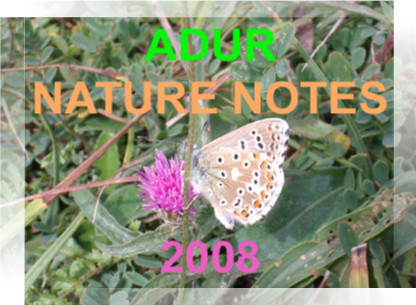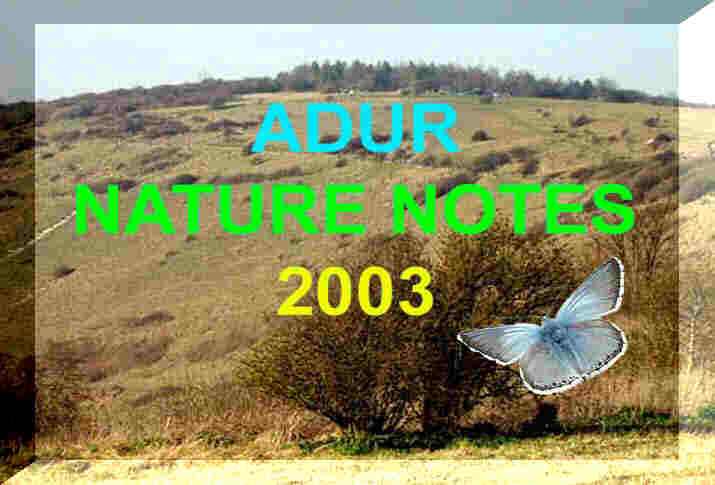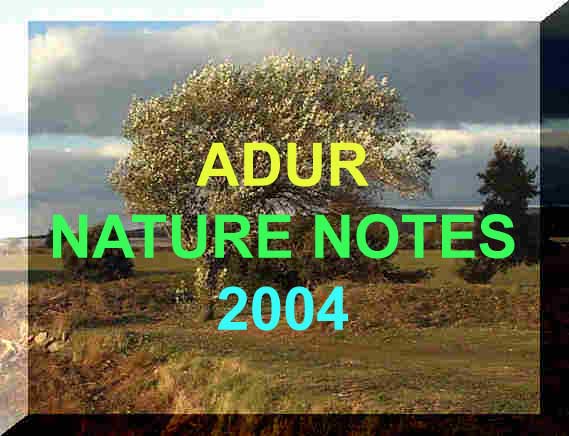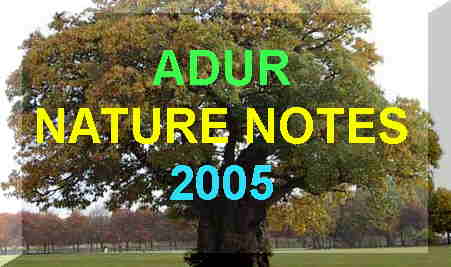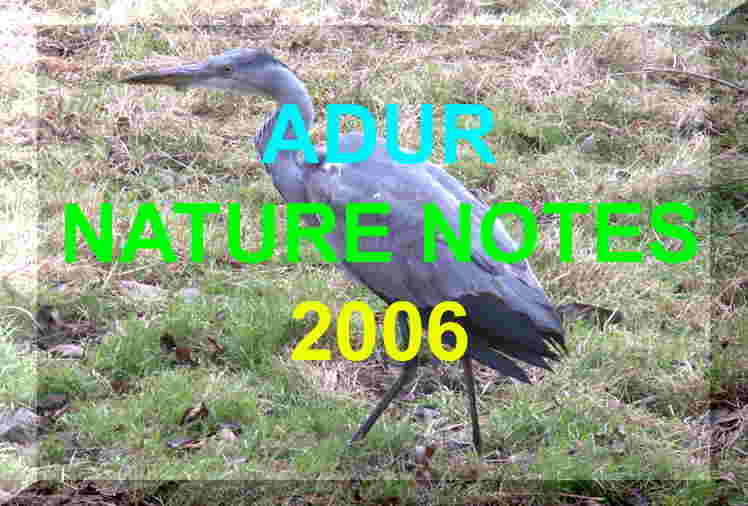including the Adur Levels, Mill Hill and the Downs Link Cyclepath to Upper Beeding and Bramber
13 November 2021
Milky Conecap
Conocybe
apala
Cyclepath verge north of Waterfront
4 January
2020
There
were Arthur's Cakes and yellow bracket
fungi on tree
stumps on Adur
Recreation Ground near the Adur
Actvities Centre.
23 October 2019
Three different groups of mushrooms at Old Fort, Shoreham Beach
The white mushrooms on the bottom right were all mushy inside but appeared to have white gills and a chunky stem.
22 October 2019
Unidentified
fungi
Silver
Sands
There
were about forty familiar but unidentified mushrooms on Silver
Sands above the high
tide
limit.
I
think these mushrooms are Marasmius
oreades (not
the
Dune
Brittlestem, Psathyrella
ammophila.)
18 October 2019
Dune
Waxcap, Hygrocybe
conicoides,
on
the Widewater Nature Reserve
Photograph
by Anthony Gammon
on World
of Widewater (WOW) facebook
This
is one of a small group of Dune Waxcaps
on the Widewater flood plain.
Adur
Waxcaps
10
October 2019
After
a week of inclement weather, there
were no butterflies seen in the breeze
on a brief visit to Mill Hill. I spotted a dozen or so large mushrooms,
including a group of White Dapperling on
the middle slopes..
.jpg) |
.jpg) |
12
June 2019
Pleated Inkcup Parasola plicatilis (=Coprinus plicatilis) My front garden, Shoreham, after the rain. |
19 March 2019
Fungus
on a tree stump
with
Lesser
Celandine
A large white mass was highly incongruous growing from a dead tree stump at the northern end of Mill Hill Drive, north Shoreham. From a distance it looked more like white paper debris; it was only when I got closer I realised it was a living organism and when identified it will probably be one of the common bracket fungi that grow on dead tree stumps. On closer inspection and it did not look like the normal bracket fungi that is frequently seen on stumps.
2018
2 May 2018
Unusual
number of Jew's Ear Fungus, Auricularia
auricula-judae
on
a dead tree in the churchyard of St. Mary de Haura
in central New Shoreham
| 11
April 2018
Three Thimble Morel, Verpa conica, mushrooms were the first I have ever seen anywhere amongst some grass below the path on the middle area of the lower slopes of Mill Hill. |
 |
| 26
September 2017
This mushroom discovered on the middle slopes of Mill Hill was thought to be a White Dapperling, Leucoagaricus leucothites, despite the absence of a stem ring. |
 |
20
August 2017
On Anchor Bottom I spotted three mushrooms: a small Puff-ball, a damaged Golden Wax Cap, Hygrocybe chlorophana, and a Common Inkcap. |
| 31
July 2017
Large, 65 mm diameter, mushrooms found occasionally on Mill Hill were the White Dapperling, Leucoagaricus leucothites, with a stem ring. |
 |
| 14
November 2016
Inkcups Coprinus atramentarius Near (east of) St.Julian's Church, Shoreham |
| 30
October 2016
Pleated Inkcup Parasola plicatilis (=Coprinus plicatilis) My front garden, Shoreham, after the rain. |
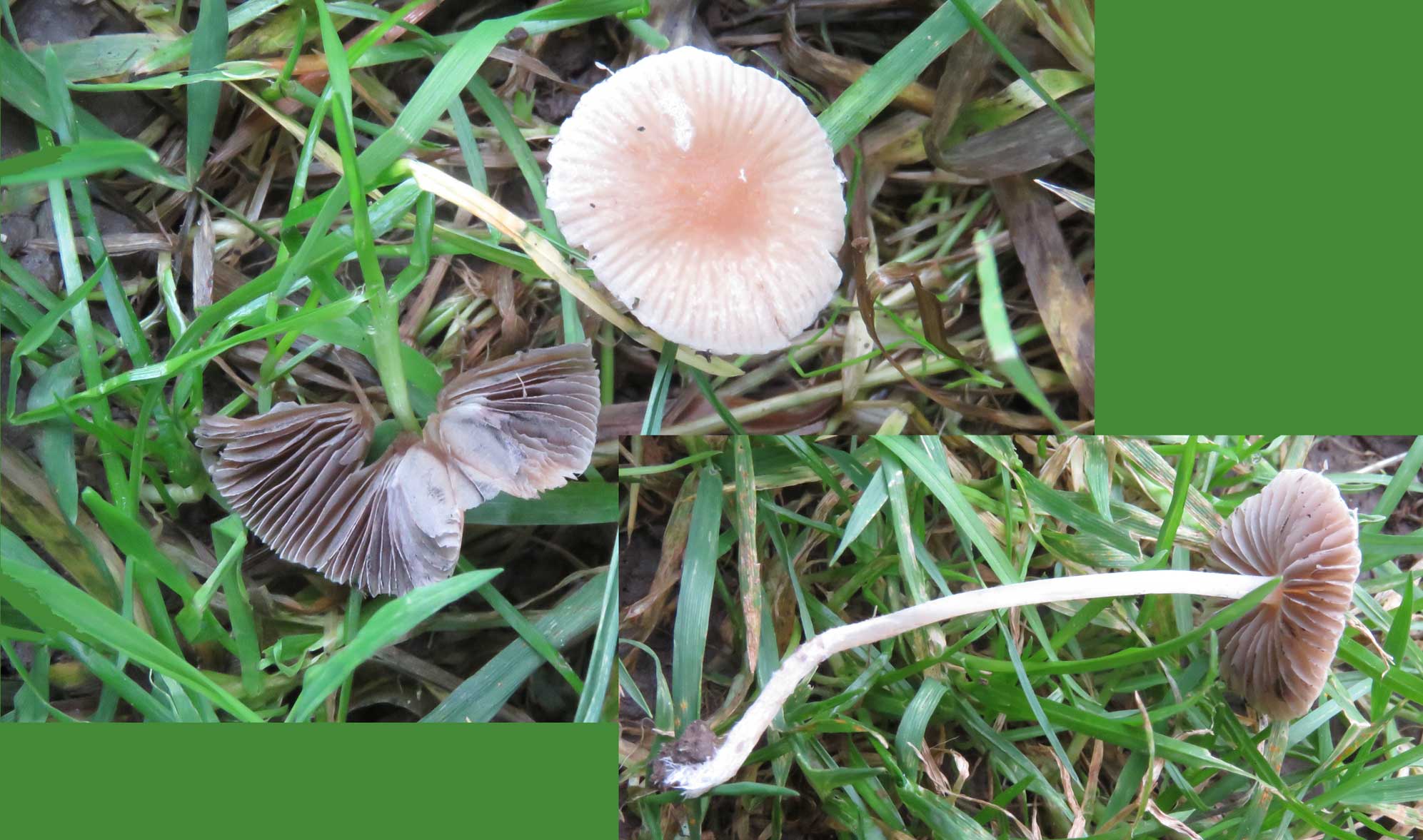 |
| 21
October 2016
Ivory Funnel Cap Clitocybe The stem was approx. 30 mm high. |
 |
 |
16
November 2015
My first large mushroom recorded this winter was one of the Blewits, Lepista sp. It was found on the towpath by Riverside Industrial Estate (north of Ropetackle) right next to the River Adur on a high spring tide. Its size was estimated at 75 mm in diameter with a stem length of about 100 mm. My best guess is the species Lepista sordida. It was growing on its own with no other fungi nearby. |
27
November 2014
 |
 |
It was very muddy when taking these shots on the verges of the cyclepath, near the Toll Bridge, Old Shoreham.
 |
20
November 2014
Volvariella gloiocephala Verges of the cyclepath, south of the Toll Bridge, Old Shoreham. Volvopluteus gloiocephalus (DC.) Vizzini, Contu & Justo - Stubble Rosegill |
29
October 2013
 |
 |
 |
|
|
|
|
I think
this one is most likely the Dune
Wax Cap, Hygrocybe
conicoides.
 |
 |
7
October 2013
Golden Wax Cap |
|
|
|
|
 |
6
October 2013
A small mushroom was found on the lower slopes of Mill Hill. It was thought to be a Stropharia dung species Maybe even Stropharia semiglobata. |
3 October
2013
 |
 |
 |
Two
of these mushrooms were seen on the towpath next to the River
Adur south of the inlet to Cuckoo's Corner.
It might be Bolbitius.
| 27
September 2013
There were what looked a species of Agaricus mushrooms on the verges of Pond Road in Shoreham on the Library side. They did not look edible. |
 |
 |
 |
 |
|
These mushrooms were frequently seen by a path and gravestones in Shoreham Cemetery, Mill Lane. Many of them were 125 mm in diameter and others were slightly larger. The stem of a 75 mm diameter specimen was 40 mm high.
This is likely to be the poisonous Brown Roll Rim Paxillus involutus Poison Pax mushroom. This was my first local record of this mushroom.
Facebook DiscussionI-Spot Entry
Eating
notes: The effects of this mushroom are cumulative over time. It might
be eaten without any apparent symptoms on several occasions then causes
an extreme allergic reaction and haemolytic anaemia. This may be fatal.
Different opinion:
Milk Cup Lactarius.
When know this in the family Russulaceae by the pale gills and shape. We can see it has red staining, which puts it in the genus Lactarius, which secrete a fluid and stain when bruised or cut, hence they "lactate". No mushrooms in the Russulaceae are deadly poisonous, although several of them can make you puke if you eat them. A good way to tell if mushrroms in the Russulaceae are edible or not is to nibble on a piece of the cap, if it is hot and spicy, they will make you sick, if mild, they are edible. Few of them are particularly tasty though.
I think the second opinion is WRONG.
 |
 |
 |
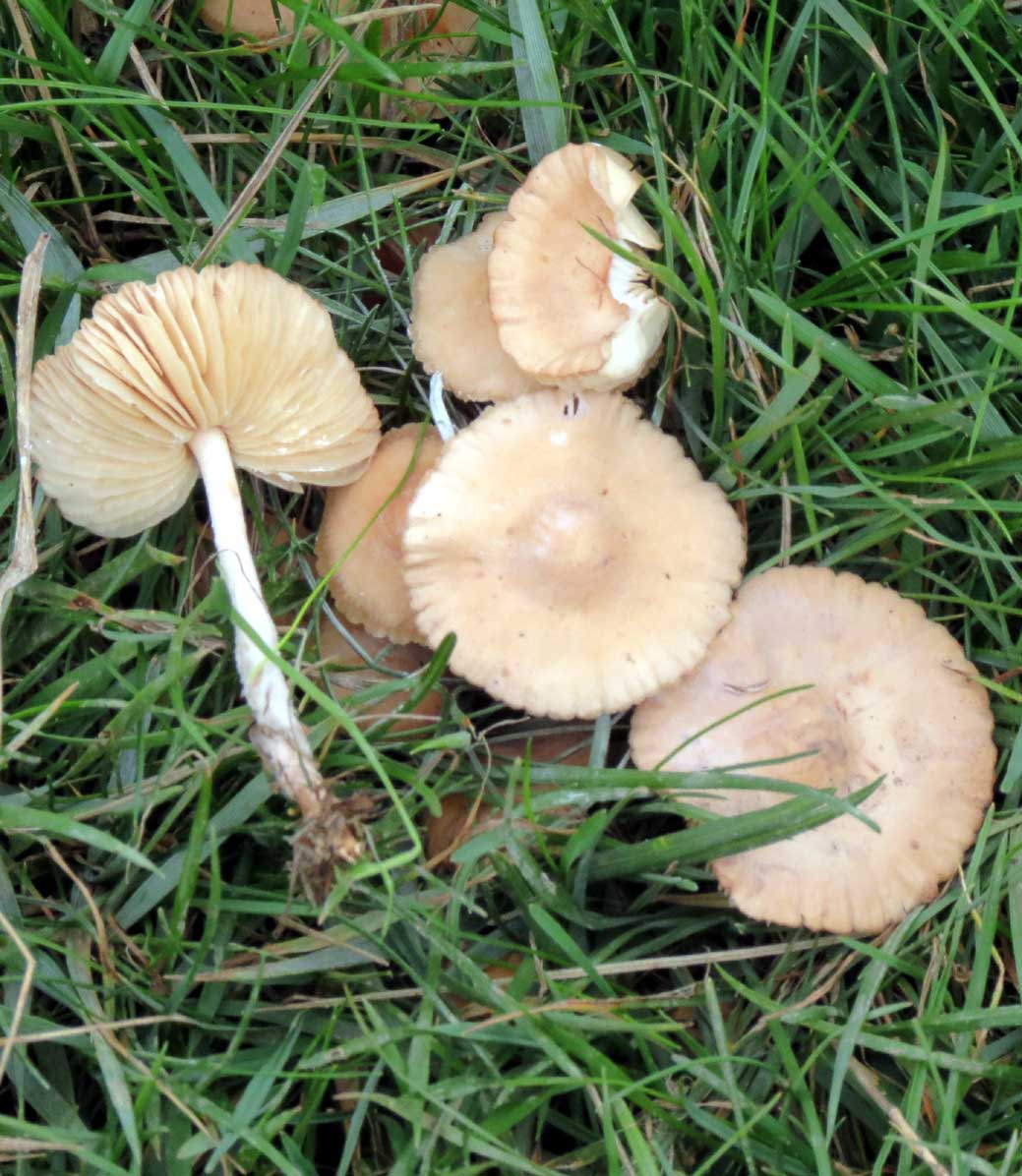 |
|
|
|
|
Marasmius oreades |
The first three were seen
on the chalk pasture at Anchor
Bottom and the one furthest on the right was seen on the edge
of the towpath of the River Adur
south of the Cement Works and this was alluvium/clay over chalk. Another
clump of this last species was seen on the verge of a car parking area
north of the Swiss Gardens lake.
 |
20
March 2013
Jew's Ear Fungus, Auricularia auricula-judae, near the Waterworks Road |
10
October 2012
I
had no intention to visit Mill
Hill when I left but a brief spell of
sunshine and I made a detour. A cloud obscured the warm rays of the sun
when
I descended to the lower slopes from the southern end.
|
|
|
 |
|
|
|
|
(without a volva) |
|
After
the rain of the previous few days, I was not
surprised to see both the algae Nostoc Commune
and the White Dapperling mushroom
on the lower slopes. On the bare patch south of the Reservoir a very large
mushroom rose above the dirt. I could not see a volva
which ruled out Volvariella gloiocephala.
I
am not sure what species it is? There
were also small clumps of Stropharia
coronilla (probably) nearby.
19 November 2010
Three Bearded Milkcaps, Lactarius pubescens, were again seen under the small Silver Birch trees on the verges of Mill Hill Road in north Shoreham. NB: This species is meant to exude a milky substance when cut, but this did not happen so there is some doubt over the identification.
15
November 2010
Not
the expected glut of mushrooms as predicted (on the BBC)
after the wet autumn, and amongst the fallen Maple leaves (the footpath
connection from the Waterworks Road
to the Steyning Road, Old Shoreham) the only fungi showing was one clump
of miniature white
Clavulina
on
a stump in the middle of the path, almost covered by the leaf litter.
| 2
November 2010
These mushrooms were seen on a stump on the lower slopes of Mill Hill. |
20
September 2010
Several
large White
Dapperling, Leucoagaricus leucothites,
mushrooms
were seen on the lower slopes of Mill Hill
about to deliquesce.
19
September 2010
One
White
Dapperling, Leucoagaricus leucothites,
mushroom on the lower slopes of Mill Hill
still had its stem ring.
10
September 2010
After
the recent rain Honey Fungus is
recorded on a wood stump on the Coastal-Downs
Link Cyclepath north of the Toll
Bridge, about midway between Old Shoreham and the Cement Works.
23
August 2010
In
the shade of my north-facing garden (after the rain), just outside my front
door (in my garden
in residential Shoreham), one inkcap
species
Coprinus
plicatilis appeared as it does in most years.
NB:
This was not the first mushroom of the year: the others went unrecorded.
| 11
December 2009
A clump of Parasol Mushrooms appeared on the eastern edge of Southwick Green. |
| 6
December 2009
Frequent Bearded Milkcaps, Lactarius pubescens, were again seen under the Silver Birch trees on the verges of Mill Hill Road, north Shoreham. There were larger specimens up an estimated 120 mm disc diameter. Clumps of the very small white fungus Clavulina grew on a stump underneath the Maple next to the Waterworks Road. |
 |
| 1
December 2009
After rain every day since my last visit to Mill Hill, all the paths were extremely muddy and the rain resulted in frequent large mushrooms with a brown cap and brown speckled white stem (without a ring) with light brown gills. The first specimen had a disc diameter of about 100 mm and a stem length of 65 mm. My tentative identification (based on previous reports) was of the species known as the Big Blue Pinkgill, Entoloma bloxamii. Later I was able to spot over a dozen smaller mushrooms of the same species. |
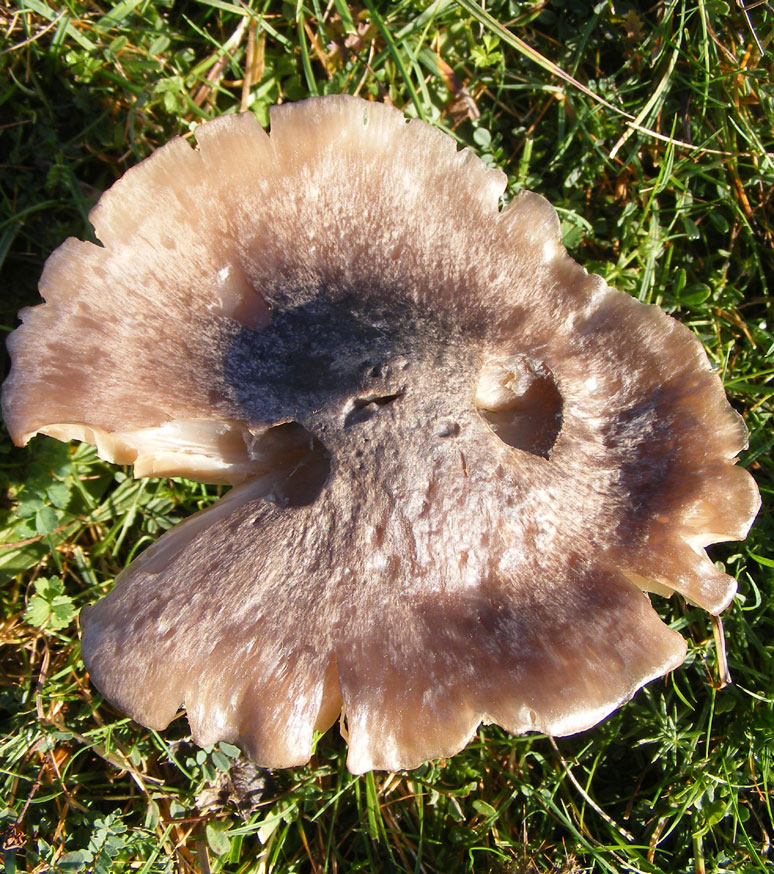 |
 |
| 1
December 2009
Two large probable Bearded Milkcap, Lactarius pubescens, mushroom were discovered under a small Silver Birch tree on the Bee Orchid verges of Mill Hill Road, north Shoreham. Previous Report 2006 |
 |
| 18
November 2009
A single large mushroom found on Shoreham Beach where the shingle was covered by soil was thought to be one of the Agaricus species. It had a stem length of approximately 120 mm and a cap diameter of about 40 mm. Agaricus devoniensis is a possibility ?? In the Maple Copse (that is footpath connection from the Waterworks Road to the Steyning Road, Old Shoreham) there were at least four large Wood Blewit mushrooms, and it looked like many more small ones pushing through the leaf litter. |
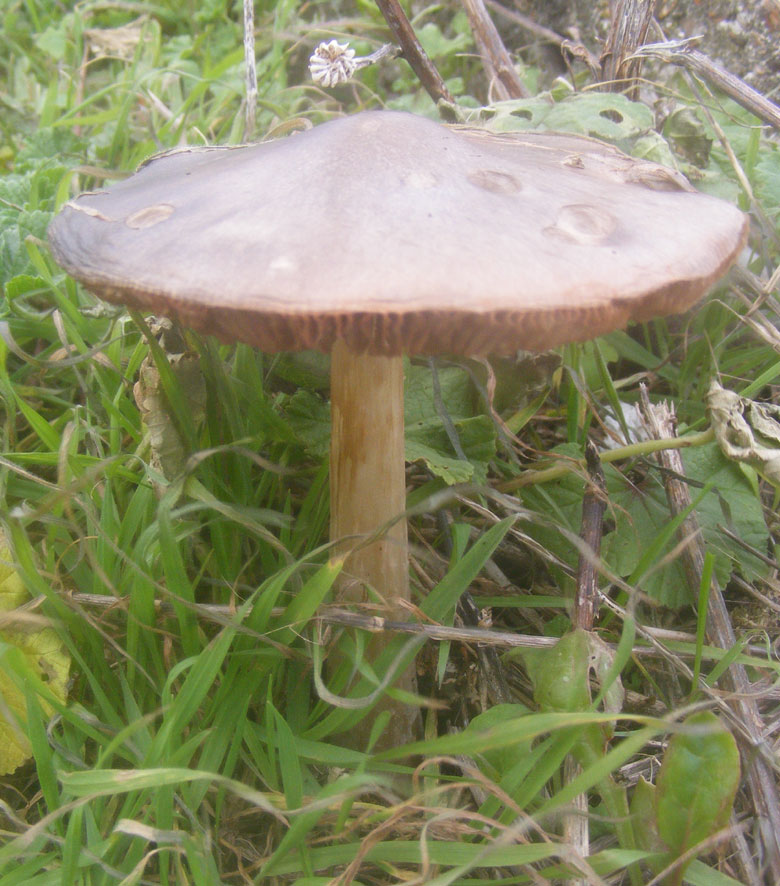 |
 |
| 9
November 2009
I was surprised to spot a Wood Blewit, Lepista nuda, mushroom on the edge of the southern steps leading down to the lower slopes of Mill Hill. It has been recorded on Mill Hill before in 2007. Familiar mushrooms found occasionally on Mill Hill were the White Dapperling, Leucoagaricus leucothites, with a stem ring, with frequent smaller Stropharia coronilla, mushrooms amongst the rabbit droppings. |
 |
 |
| The were more small Dune Wax Caps, Hygrocybe conicoides, on the Pixie Path, Old Shoreham, with orange stem and gills and a red cap. |
|
|
| 7
November 2009
The waxcaps of three days previously on the Pixie Path were not seen but at least two very small waxcaps appeared in the very shirt grass and herbs further up the path towards the east. These
were both smaller and had red stems. It
may have been the Scarlet Waxcap Hygrocybe
coccinea.
|
 |
| 5
November 2009
Fungi underneath the Lancing Clump included the usual Puff Balls, Shaggy Pholiota, Sulphur Tuft and King Alfred's Cakes. Two large Pholiota were discovered in the mown meadows. |
 |
 |
|
|
|
| 4
November 2009
Two fruiting bodies of the Dune Wax Cap, Hygrocybe conicoides, were spotted on the Pixie Path, Old Shoreham, near the north-west corner of Frampton's Field. The stem in these mushrooms were orange. Occasional White Dapperling, Leucoagaricus leucothites, were seen above the ridge on Mill Hill with frequent smaller Dung Fungus, Stropharia semiglobata, mushrooms. Honey Fungus was seen on a roadside kerb in Southwick. Adur Wax Caps |
 |
 |
29
October 2009
These small mushrooms were frequently seen in the short grass at the top of Chanctonbury Drive (SE of the Mill Hill bridge). This is a species Coprinus plicatilis. On the Hawthorn stumps on Mill Hill the Honey Fungus was noted. On the steps in the north-western part of Mill Hill Nature Reserve a few Common Ink Caps, Coprinus atramentarius, were present. |
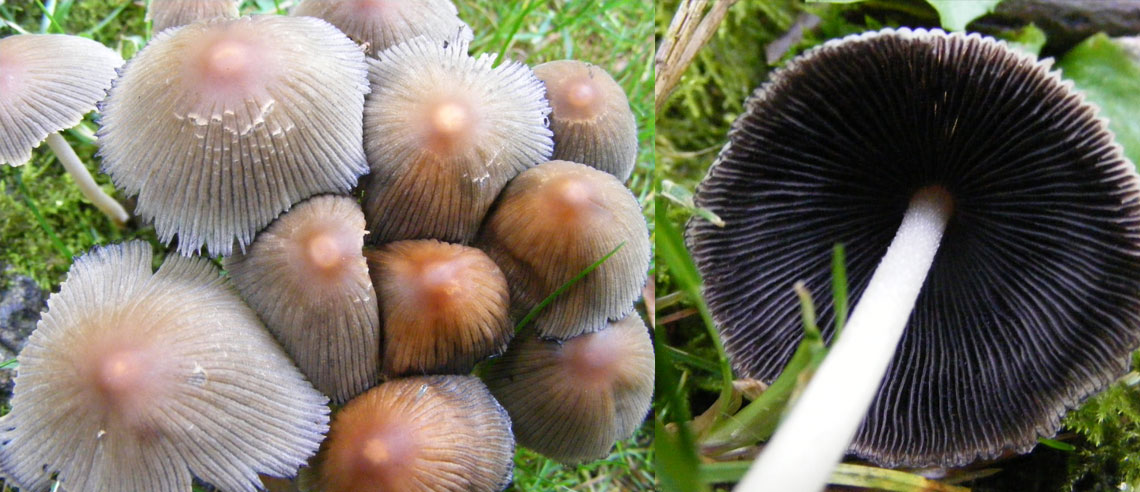 |
Coprinus atramentarius |
 |
15
October 2009
Several large Bracket Fungi grew on a dead tree in the churchyard of St. Mary de Haura in central New Shoreham. They were about two metres up the tree. |
| 12
October 2009
After the rain of the preceding few days it was only a surprise that there were not more of the small mushrooms Stropharia on the middle slopes of Mill Hill. Only one was seen. |
 |
| 12
June 2009
A solitary Snowy Ink Cap was spotted on a cow pat on Anchor Bottom, Upper Beeding. |
 |
 |
 |
|
|
|
| 16
November 2008
Common Ink Caps were seen in Kingston Buci. 16
November 2008
|
 |
7 November
2008
 |
Small mushrooms amongst Rabbit droppings on Mill Hill, believed to be the Dung Fungus, Stropharia species. |
28
October 2008
 |
Mushrooms (a few) on the verges of the Coastal Link Cyclepath north of the Cement Works. These were a largish species, mostly about the size of supermarket standard mushrooms and the one photographed was one third larger than that. The gills were white in the upright specimen. |
12
October 2008
There
was a Coprinus plicatilis on
the upper part of Mill Hill.
Mushroom
Identifier
9 October
2008
The
first Ink Caps
of the autumn were seen in large clumps totalling over a hundred caps on
a new verge created by the realignment of the Coastal
Link Cyclepath just north of the Adur
Riverbank Industrial Estate.
 |
 |
| 9
October 2008
Ink Cap Mushrooms Location: Coastal Link Cyclepath just north of the Adur Riverbank Industrial Estate |
16
September 2008
Parasol Mushroom Location: Southwick Green |
9 September
2008
After
four days of rain, a few mushrooms appeared.
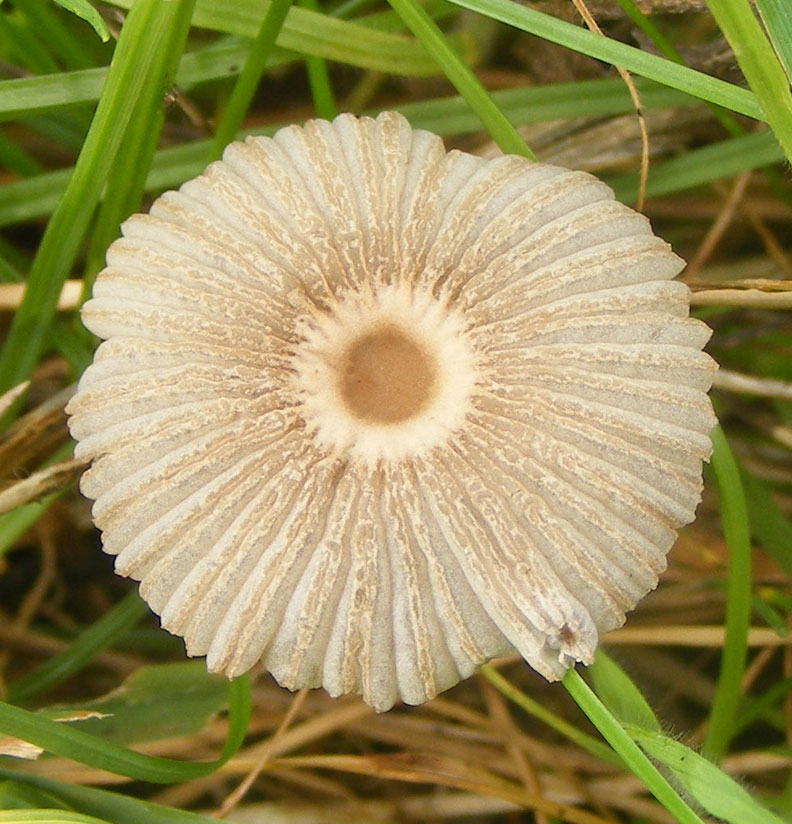 |
 |
 |
 |
|
on Mill Hill, upper |
on the towpath near Cuckoo's Corner |
Stropharia
coronilla
|
|
2 September
2008
After
the wettest August
in my lifetime of over 50 years, Agaric mushrooms appeared in St.
Mary de Haura churchyard in central Shoreham.
 |
 |
 |
After
the rain of the last few days, three species of mushroom have appeared,
two of them, one a Snowy Ink Cap,
Coprinus
niveus, on the cow pats still remaining
two months after the cattle had been removed from Mill
Hill. The mushroom on the far right is probably Stropharia
coronilla. This one was discovered on the
well trodden (especially by cattle) area immediately to the north-west
of the Reservoir with a smaller mushroom of the same species discovered
on the Pixie Path.
Chalkhill
Fungi
 |
|
This
small mushroom was discovered on Mill Hill
just above the ridge above the steep lower
slopes. I think this was Stropharia coronilla.
Chalkhill
Fungi
1 February
2008
 |
 |
A mown McIntyres Field, Lancing contained frequent mushrooms illustrated above. The largest of these mushrooms were estimated at 65 mm cap diameter. The one on the left above was much smaller and is only assumed to be the same species.
1 January 2008
My first mushroom of 2008 was a Blewits, Lepista sp., recorded from the ridge of Mill Hill. I originally identified this as a Field Blewits, Lepista saeva, but this species has no blue on its cap.
I'd
go for the rather variable Lepista
sordida for both of those, but
you really need to measure the spores to be sure. Lepista
sordida is the only Lepista
which
can be completely blue/purple all over, but it can also have hardly any
blue at all. It favours disturbed and garden situations (probably slightly
raised fertility but overlaps in this with Wood
Blewits)
Lepista
saeva doesn't have any blue/purple in the cap.
I
am sure I remember reading years ago that the traditional English name
for these is "a blewits"
- one of those words like "a thrips" where the singular ends in "s", but
have been unable to trace this.


.jpg)
.jpg)














